Some researchers have observed that apes held in captivity watch tv programmes. Some of them are fond of the Teletubbies, others favour emergency room dramas or Disney cartoons. But is it possible to script, shoot and screen cinema just for primates? That’s what Rachel Mayeri set out to discover with her work Primate Cinema: Apes as Family.
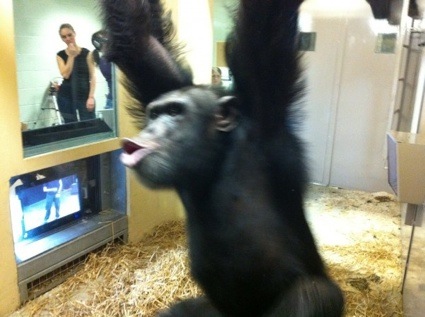
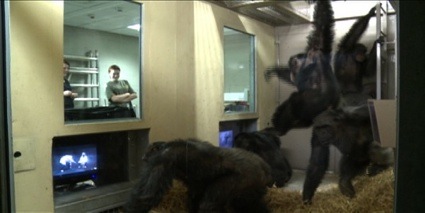
The artist worked with Stirling University comparative psychologist Dr Sarah-Jane Vick to identify which kind of action, narrative or images a group of chimpanzees from the Edinburgh Zoo were most receptive too. The scientist and the artist observed how monkeys reacted to documentaries, cartoons, dramas screened inside a research pod where the animals could pop in and out as they pleased. The monkeys would spend a few minutes in front of the images then go away, come back, sit down for a moment, get up and bang violently against the wall that protect the tv screen, etc. Unsurprisingly the monkeys reacted more strongly to scenes featuring sex, food, violence but they were also interested in drumming and seemed quite fascinated by humans dressed as monkeys and by humans removing their monkey masks.
The result of the artist’s research is a 20 minute movie. The video installation juxtaposes two screens. The right screen shows the movie for apes, its stars are actors dressed as and acting like monkeys. The second half displays the reactions of the ape audience when the film was shown on a chimp-proof screen at Edinburgh Zoo last August.
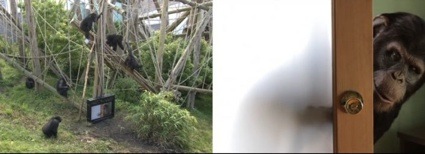
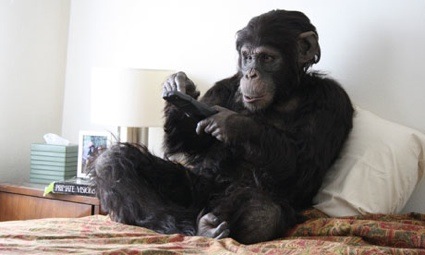 Rachel Mayeri, Primate Cinema: Apes As Family. Photograph: Matt Chaney
Rachel Mayeri, Primate Cinema: Apes As Family. Photograph: Matt Chaney
The hero of the film for monkeys is an actress wearing an animatronic suit with motorized eyes that are controlled by a puppeteer. She enters a house, gets a soda from the fridge, goes upstairs and falls asleep in front of the tv. Soon, a group of chimpanzee intruders enter the house as well and start misbehaving: they help themselves to the bananas and carrots in the fridge and basically trash the house. The clatter wakes up our chimp heroine. She gets up and goes downstairs to see what’s the tumult about. That’s when the plot thickens. Because chimpanzees also appreciate to watch social and sexual dynamics on screen.
Last week, i went to listen to the artist at Cinema as Primatology, a symposium organized by The Arts Catalyst.
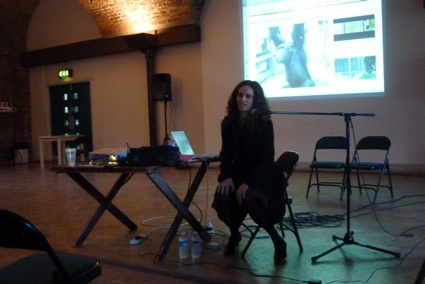 Rachel Mayeri talking to the audience at the symposium
Rachel Mayeri talking to the audience at the symposium
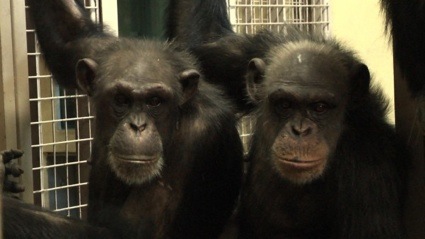
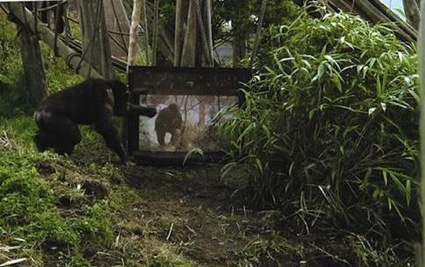
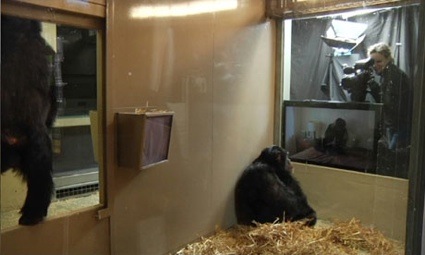
Rachel Mayeri told us a few thought-provoking facts during her presentation:
– chimps might like to watch tv but that only happens when they are in captivity. Left in the wild, they have far more interesting things to do than watch tv.
– even the zoo is not the most suitable place to study the reaction of monkeys to moving images as the chimps’ backgrounds may vary dramatically: some were rescued from poachers, others used to be mascots, some were born in captivity, etc.
– it’s not correct to say that we descend from chimps as they haven’t stayed exactly the same while we were evolving, our closest cousins have evolved too.
– chimps don’t focus solely on the images appearing on the TV, they regularly check the changing social situation around them. They monitor each other (“who around me is sexually available?” for example) just like we do on facebook. Two of the most ‘avid’ tv watchers were a mother and daughter. During the research, the females were the ones who spent most time watching the tv screen. On the day of the screening of the finished movie for chimps at the Edinburgh Zoo, they were in rut, distracted and the center of male attentions.
– The artist is conscious that she made a film that reflects her own, very human prejudices and ideas of what a film should be like. She therefore asked herself “If a chimp director had to do a film for humans, would it have done the same mistakes and made a film for chimps rather than one for humans?”
Trailer for Primate Cinema: Apes as Family
Rachel also showed an extract of her first Primate Cinema video experiments, Baboons as Friends. In the two channel video installation, field footage of baboons are shown next to a reenactment by human actors, shot in film noir style.
The work was inspired by primatologist Deborah Forster who, unlike most people, can watch babboons for hours as if they were actors in a soap opera. The artist attempted to translate the plot of lust, jealousy, sex, and violence into the human world.
Primate Cinema: Apes as Family is at The Arts Catalyst in London until 13 November 2011.
Primate Cinema: Apes as Family has received financial support from a Wellcome Trust Arts Award and was filmed in the Budongo Trail at Edinburgh Zoo.
